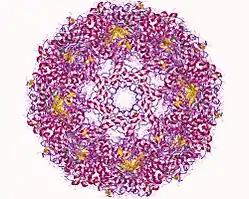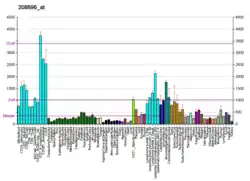CCT5 (gene)
T-complex protein 1 subunit epsilon is a protein that in humans is encoded by the CCT5 gene.[5]
Function
This gene encodes a molecular chaperone that is member of the TRiC complex. This complex consists of two identical stacked rings, each containing eight different proteins. Unfolded polypeptides enter the central cavity of the complex and are folded in an ATP-dependent manner. The complex folds various proteins, including actin and tubulin. Alternate transcriptional splice variants of this gene have been observed but have not been thoroughly characterized.[5]
References
- GRCh38: Ensembl release 89: ENSG00000150753 - Ensembl, May 2017
- GRCm38: Ensembl release 89: ENSMUSG00000022234 - Ensembl, May 2017
- "Human PubMed Reference:". National Center for Biotechnology Information, U.S. National Library of Medicine.
- "Mouse PubMed Reference:". National Center for Biotechnology Information, U.S. National Library of Medicine.
- "Entrez Gene: CCT5 chaperonin containing TCP1, subunit 5 (epsilon)".
- Chen GI, Tisayakorn S, Jorgensen C, D'Ambrosio LM, Goudreault M, Gingras AC (Oct 2008). "PP4R4/KIAA1622 forms a novel stable cytosolic complex with phosphoprotein phosphatase 4". The Journal of Biological Chemistry. 283 (43): 29273–84. doi:10.1074/jbc.M803443200. PMC 2662017. PMID 18715871.
- Gingras AC, Caballero M, Zarske M, Sanchez A, Hazbun TR, Fields S, Sonenberg N, Hafen E, Raught B, Aebersold R (Nov 2005). "A novel, evolutionarily conserved protein phosphatase complex involved in cisplatin sensitivity" (PDF). Molecular & Cellular Proteomics. 4 (11): 1725–40. doi:10.1074/mcp.M500231-MCP200. PMID 16085932. S2CID 7531012.
External links
- Human CCT5 genome location and CCT5 gene details page in the UCSC Genome Browser.
Further reading
- Roobol A, Holmes FE, Hayes NV, Baines AJ, Carden MJ (Apr 1995). "Cytoplasmic chaperonin complexes enter neurites developing in vitro and differ in subunit composition within single cells". Journal of Cell Science. 108 (4): 1477–88. PMID 7615668.
- Nagase T, Miyajima N, Tanaka A, Sazuka T, Seki N, Sato S, Tabata S, Ishikawa K, Kawarabayasi Y, Kotani H (1995). "Prediction of the coding sequences of unidentified human genes. III. The coding sequences of 40 new genes (KIAA0081-KIAA0120) deduced by analysis of cDNA clones from human cell line KG-1". DNA Research. 2 (1): 37–43. doi:10.1093/dnares/2.1.37. PMID 7788527.
- Kubota H, Hynes G, Carne A, Ashworth A, Willison K (Feb 1994). "Identification of six Tcp-1-related genes encoding divergent subunits of the TCP-1-containing chaperonin". Current Biology. 4 (2): 89–99. doi:10.1016/S0960-9822(94)00024-2. PMID 7953530. S2CID 31300131.
- Liou AK, Willison KR (Jul 1997). "Elucidation of the subunit orientation in CCT (chaperonin containing TCP1) from the subunit composition of CCT micro-complexes". The EMBO Journal. 16 (14): 4311–6. doi:10.1093/emboj/16.14.4311. PMC 1170057. PMID 9250675.
- Roperch JP, Lethrone F, Prieur S, Piouffre L, Israeli D, Tuynder M, Nemani M, Pasturaud P, Gendron MC, Dausset J, Oren M, Amson RB, Telerman A (Jul 1999). "SIAH-1 promotes apoptosis and tumor suppression through a network involving the regulation of protein folding, unfolding, and trafficking: identification of common effectors with p53 and p21(Waf1)". Proceedings of the National Academy of Sciences of the United States of America. 96 (14): 8070–3. doi:10.1073/pnas.96.14.8070. PMC 22189. PMID 10393949.
- Yanaka N, Kobayashi K, Wakimoto K, Yamada E, Imahie H, Imai Y, Mori C (May 2000). "Insertional mutation of the murine kisimo locus caused a defect in spermatogenesis". The Journal of Biological Chemistry. 275 (20): 14791–4. doi:10.1074/jbc.C901047199. PMID 10747865.
- Yoo BC, Kim SH, Cairns N, Fountoulakis M, Lubec G (Jan 2001). "Deranged expression of molecular chaperones in brains of patients with Alzheimer's disease". Biochemical and Biophysical Research Communications. 280 (1): 249–58. doi:10.1006/bbrc.2000.4109. PMID 11162507.
- Yoo BC, Vlkolinsky R, Engidawork E, Cairns N, Fountoulakis M, Lubec G (Apr 2001). "Differential expression of molecular chaperones in brain of patients with Down syndrome". Electrophoresis. 22 (6): 1233–41. doi:10.1002/1522-2683()22:6<1233::AID-ELPS1233>3.0.CO;2-M. PMID 11358150.
- Yokota S, Yanagi H, Yura T, Kubota H (Sep 2001). "Cytosolic chaperonin-containing t-complex polypeptide 1 changes the content of a particular subunit species concomitant with substrate binding and folding activities during the cell cycle". European Journal of Biochemistry / FEBS. 268 (17): 4664–73. doi:10.1046/j.1432-1327.2001.02393.x. PMID 11532003.
- McCormack EA, Llorca O, Carrascosa JL, Valpuesta JM, Willison KR (Aug 2001). "Point mutations in a hinge linking the small and large domains of beta-actin result in trapped folding intermediates bound to cytosolic chaperonin CCT". Journal of Structural Biology. 135 (2): 198–204. doi:10.1006/jsbi.2001.4385. PMID 11580269. Check date values in:
|year= / |date= mismatch(help) - Llorca O, Martín-Benito J, Gómez-Puertas P, Ritco-Vonsovici M, Willison KR, Carrascosa JL, Valpuesta JM (Aug 2001). "Analysis of the interaction between the eukaryotic chaperonin CCT and its substrates actin and tubulin". Journal of Structural Biology. 135 (2): 205–18. doi:10.1006/jsbi.2001.4359. PMID 11580270. Check date values in:
|year= / |date= mismatch(help) - Guenther MG, Yu J, Kao GD, Yen TJ, Lazar MA (Dec 2002). "Assembly of the SMRT-histone deacetylase 3 repression complex requires the TCP-1 ring complex". Genes & Development. 16 (24): 3130–5. doi:10.1101/gad.1037502. PMC 187500. PMID 12502735. Check date values in:
|year= / |date= mismatch(help) - Ludwig A, Dietel M, Lage H (2003). "Identification of differentially expressed genes in classical and atypical multidrug-resistant gastric carcinoma cells". Anticancer Research. 22 (6A): 3213–21. PMID 12530067.
- Imai Y, Soda M, Murakami T, Shoji M, Abe K, Takahashi R (Dec 2003). "A product of the human gene adjacent to parkin is a component of Lewy bodies and suppresses Pael receptor-induced cell death". The Journal of Biological Chemistry. 278 (51): 51901–10. doi:10.1074/jbc.M309655200. PMID 14532270. Check date values in:
|year= / |date= mismatch(help) - Lehner B, Sanderson CM (Jul 2004). "A protein interaction framework for human mRNA degradation". Genome Research. 14 (7): 1315–23. doi:10.1101/gr.2122004. PMC 442147. PMID 15231747.
- Lukov GL, Hu T, McLaughlin JN, Hamm HE, Willardson BM (Jun 2005). "Phosducin-like protein acts as a molecular chaperone for G protein betagamma dimer assembly". The EMBO Journal. 24 (11): 1965–75. doi:10.1038/sj.emboj.7600673. PMC 1142607. PMID 15889144.
- Stelzl U, Worm U, Lalowski M, Haenig C, Brembeck FH, Goehler H, Stroedicke M, Zenkner M, Schoenherr A, Koeppen S, Timm J, Mintzlaff S, Abraham C, Bock N, Kietzmann S, Goedde A, Toksöz E, Droege A, Krobitsch S, Korn B, Birchmeier W, Lehrach H, Wanker EE (Sep 2005). "A human protein-protein interaction network: a resource for annotating the proteome". Cell. 122 (6): 957–68. doi:10.1016/j.cell.2005.08.029. hdl:11858/00-001M-0000-0010-8592-0. PMID 16169070. S2CID 8235923.
This article is issued from Wikipedia. The text is licensed under Creative Commons - Attribution - Sharealike. Additional terms may apply for the media files.





